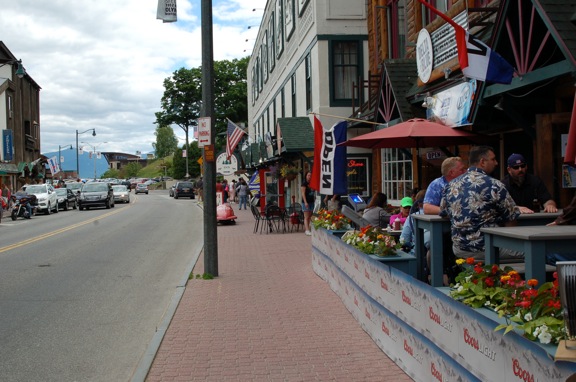EYE ON BUSINESS: Understanding ROOST’s tourism survey results

Diners enjoy a meal at the Delta Blue restaurant on Main Street, Lake Placid, in 2014. (News photo — Andy Flynn)
LAKE PLACID – Running a business isn’t just about offering a good product or service. It’s about offering that good product or service to the person who’s actually going to buy, and finding that person requires sifting through tons of data.
The Regional Office of Sustainable Tourism, based in Lake Placid, handles promotions and tourism marketing for Essex, Franklin and Hamilton counties. The websites for Lake Placid, Saranac Lake and Tupper Lake that feature information such as restaurants, special events and places to stay are all ROOST websites.
ROOST recently released the results of its 2017 Leisure Travel Study. It’s a collection of data on who comes here, how long they stay and what they do when traveling to the North Country. Not everyone who visits the North Country takes these surveys, so while 5,345 people responded, much more actually vacationed in the Adirondacks in 2017. There is usually an incentive to take surveys, such as a chance to win an iPad or a stay at a Lake Placid hotel.
ROOST Director of Digital Marketing Jasen Lawrence said the leisure studies, which cost about $27,000 and have been conducted by a third party for almost 15 years, were originally designed to see if ROOST was making a return on invest (ROI) from the occupancy tax in the three counties.
The 3 percent occupancy or “bed tax” is a tax put on rooms in hotels, motels, vacation rentals and Airbnbs. That collected tax money goes to ROOST.
Later, ROOST added more questions to the surveys to get a sense of the people who visit the region.
“The study has slowly expanded over time,” Lawrence said. “This year, we expanded, and there are several important questions on short-term rentals and things like that. [The study] has broadened its scope in a big way. The big reason we do this is to understand the traveler, and this study still has an ROI number, and so we use that.”
This year the ROI was 62 to 1.
“So every dollar that we were given from occupancy tax, there was $62 in direct spend from the travelers here,” Lawrence said.
The main finding in this year’s leisure study was that white, upper-middle-class visitors are the most abundant, they come here for recreational activities such as hiking and paddling and they’re staying fewer days than tourists have in past years.
“Hiking” can be a stretch sometimes, though. Some people who take the surveys consider the walk around Mirror Lake a hike, Lawrence said.
“That showed us, in terms of market messaging, we shouldn’t talk about or show people the bobsled and how they can see the bobsled experience,” he said. “That wasn’t the primary market message anymore. It should really be about getting out on the water with a paddle. Those sorts of messages make more sense and resonate better with people who want to come here.”
Once you have this data, what’s the point? What can you do with it? How does a local business take advantage of these findings? This is the piece ROOST is still working on, Lawrence said.
“A good example would be if someone says, ‘Jeez, my business is really suffering. Why am I down? I heard that my neighbors say occupancy there is up, so why am I down?’ They can take that opportunity and look at what the data says about who a traveler is.”
Lawrence said some businesses have made important decisions based on findings from the leisure study data.
“We’ve had some people who were interested in building major renovations of properties,” he said, “and they’ve absolutely said, ‘You know, I looked at this data before deciding to make a purchase or make a major renovation in the Adirondacks because they could see the traveler demographic and they could see that growth over time and get a good picture of what that marketing would be like.”
The studies also show business where to advertise, Lawrence said.
“What’s really fascinating is when you look at the county breakdowns of demographics because there are three separate reports. Franklin County, especially northern and Tupper Lake, draw more from western New York, and here in Lake Placid and Essex County, we draw from southern Albany and the New York metro area.
“If you want, you can plug in an ad algorithm on the internet that targets single, female, dog lovers, under 40 from Long Island. You can advertise to pretty much anyone these days.”
Golden Arrow Lakeside Resort General Manager Jen Holderied called the surveys useful documents, especially when looked at over long periods of time.
“The ROOST data is helpful for looking at larger trends,” she said. “Just being in contact with ROOST, in general, helps shape our marketing dollars.”
Understanding ROOST data is not a quick process, Holderied said.
“It’s a lot of information. It doesn’t take five minutes. You’ve got to mine through it and take your time.”
Holderied said the Golden Arrow already has its own studies and surveys in place to help understand visitors. What they mainly look for is the demographic and from where guests are coming. The ROOST studies almost act like a second opinion.
“[ROOST studies] help confirm things you already know because you’re looking at the data retroactively,” she said.





